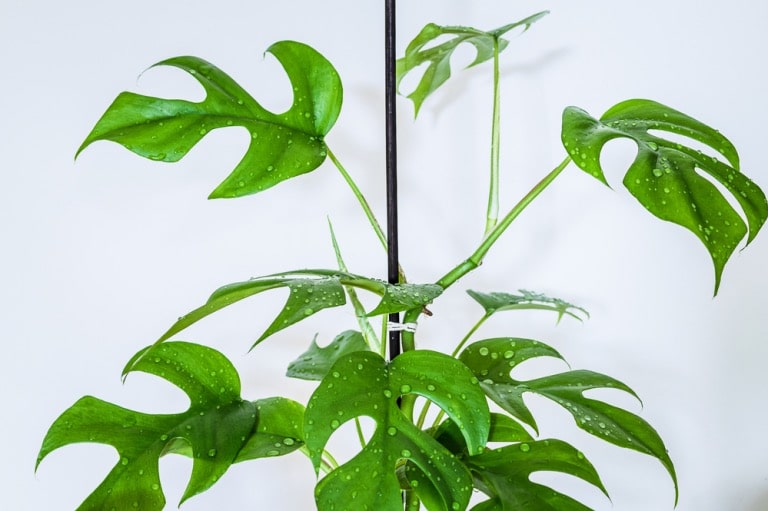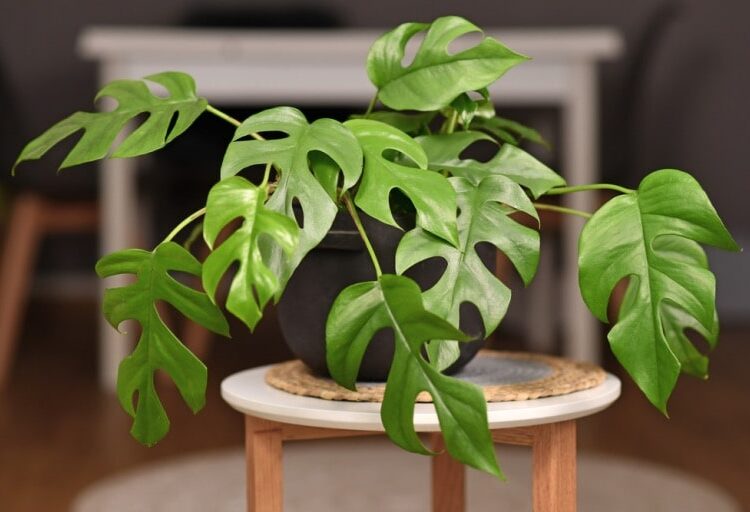The Rhaphidophora tetrasperma is a fascinating and popular choice for those passionate about growing houseplants. Commonly referred to as “Mini Monstera,” this beautiful vining houseplant may initially appear hard to nurture. However, with the right tools, growing it is pretty easy.
In this post, I’m going to explain the process of caring for this stunning plant, revealing valuable insights into its maintenance and growth. I’ll also be sharing tips to help you understand how to cultivate your Rhaphidophora plant in your home successfully.
Let’s jump right into it!
What You Need to Grow Rhaphidophora Tetrasperma
Growing Rhaphidophora tetrasperma at home is a great way to add a touch of greenery to any space. But before you start planting, you’ll need a few things:
1. Pot
First, you’ll need a pot at least 10 inches deep and 8 inches in diameter. Make sure it has good drainage and bottom holes to let water out.
You can also go for a self-watering container to make things easier.
2. Potting Soil
You’ll also need potting soil formulated for growing plants. Look for one that has fast-draining capabilities to prevent root rot.
Once you have the soil, mix it with equal amounts of perlite and peat moss. This will help create a light and airy environment, so your plant can thrive.
3. Rhaphidophora Stem
For the final step, you’ll need Rhaphidophora tetrasperma cutting or stem available online or in local nurseries.
Once you have all these ingredients, you’re ready to start planting!
Choosing the Right Location
Once you have your Rhaphidophora tetrasperma, you should choose the right location for the plant. Ideally, pick an area where your plant will receive indirect sunlight and temperatures to remain constant throughout the year.
Situate your plant near a window that’s exposed to bright but indirect sunlight in the winter. If there isn’t a suitable area in your house, you can provide your Rhaphidophora natural light with grow lights or a desk lamp.
In terms of temperature, non-air-conditioned rooms are the best option for your Rhaphidophora. If a room is too warm or cold, your plant won’t be able to flourish. Keep your plant away from cold air drafts, radiators, and heating vents if possible.
It’s best to ensure the area you intend to grow your plant in is spacious enough to accommodate its possible size and growth rate. Keep in mind that Rhaphidophora tetrasperma can grow several feet tall and wide.
However, provide your plant with the proper environment. This gorgeous and easy-to-care-for houseplant will bring life into any indoor space.
Caring for Your Rhaphidophora Tetrasperma
Caring for a Mini Monstera is easier than it seems. With the right level of commitment, you can ensure your plants will stay healthy.
Here are six basic needs of your Mini Monstera:
- Light: This plant enjoys bright, indirect light. Avoiding direct sunlight is vital as it can burn the leaves and cause discoloration.
- Humidity and Temperature: A humid environment is essential for Rhaphidophora to thrive. I recommend spraying the leaves with water daily. Temperature-wise, 65℉-75℉ is ideal; below 65℉ can cause dwarfism.
- Watering: During your plant’s growth period, water it well as soon as the soil is dry. When your Rhaphidophora goes dormant in winter, you should reduce watering and only do it when needed.
- Fertilizing: Fertilize your Rhaphidophora during the spring and summer months with an all-purpose fertilizer reduced to half its strength once every two weeks. Never fertilize during fall or winter when growth is slower or not present.
- Soil Repotting: Because this variety of plants tends to grow quickly during its growing season, repotting is vital at least once a year when changing the soil. Ensure that the soil is moist and well-draining!
- Pruning: Pruning should be done every season to control growth, remove dead leaves or stems, and shape your plant by beautifying it. Pruning can help new leaves develop healthier and fuller.
Common Issues With Rhaphidophora Tetrasperma

A few things could go wrong when growing your Mini Monstera, and knowing how to deal with them is essential.
Here are some tips for tackling the most common problems:
1. Brown Tips
If you start noticing some brown tips on your plant’s leaves, it’s likely because you’ve overwatered or exposed it to direct sunlight.
To combat this, reduce watering frequency and keep your plant away from direct sunlight.
2. Yellowing Leaves
Suppose you’re seeing some yellow leaves on your Rhaphidophora plant. In that case, it’s probably due to too much fertilizer usage or lack of water or light.
Make sure to check if you’ve applied fertilizer regularly and check soil moisture before providing additional water. Giving your plant more but not too much light may help restore its lush green color.
3. Stunted Growth
This can happen because of improper planting conditions, like soil quality and insufficient light. Your pot should be well-drained to ensure Rhaphidophora grows properly, and the potting mix should have proper air circulation.
Give your plant plenty of high-intensity light, and be cautious of excessive heat or cold wind near the potting area. You can quickly fix your plant’s growth issue with proper care and attention.
4. Weakened Crisp Leaves
To prevent weakened or crisp leaves, you should consider focusing on these common issues:
- Underwatering
- Overwatering
- Low humidity
- Temperature Changes
- Nutrient Deficiency
To fix this, you’ll need to remove your plant from the soil and place it in another pot with water. The process will take a few weeks for new roots to grow. Once new roots have developed, you can place the plant in moisturized soil.
Conclusion
Growing your own Rhaphidophora tetrasperma is an enjoyable experience that can transform your space into a fascinating and vibrant one. All you need is patience, dedication, and a sense of adventure.
With the proper knowledge and care, you can raise this unique houseplant until it’s fully grown and admire its characteristics for years.




